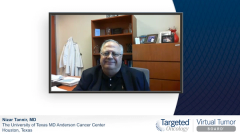
DFS vs OS Primary Endpoints in KEYNOTE 564
Scott Tykodi, MD, PhD, discusses using DFS as a primary end point in trials, as well as the usage of biomarkers.
Episodes in this series

Nizar Tannir, MD: I’m going to turn to you, Scott. Do you believe DFS [disease-free survival] as the primary end point is appropriate? Obviously, the FDA thinks so, and that’s why all these adjuvant trials have used DFS as the primary end point. If a trial meets the DFS end point but doesn’t meet the OS [overall survival] end point, are you OK with that? That’s one question I’d like you to address.
Second, you’ve done a lot of translational research, and you think of biomarkers. As Moshe alluded to, I’m sure there’s an effort from KEYNOTE-564 to look at biomarkers in those patients to see if there’s a subgroup of patients who benefit from adjuvant pembrolizumab and will be cured with 1 year of adjuvant pembrolizumab rather than have relapse and unfortunately die by not receiving adjuvant therapy within 12 weeks from nephrectomy. It’s like the data from the adjuvant therapy with an anti–PD-1 in bladder cancer. Is DFS a good end point, even if OS isn’t met? And talk about biomarkers.
Scott Tykodi, MD, PhD: The issue of OS and adjuvant therapy is challenging. Obviously, we’d love to have an OS end point, but it adds time to the analysis and elements beyond the control of the study that you’ve designed. Up until when the patient progresses, they’re governed by the study and the study therapies. After they progress, they can receive any treatment you choose. You’re trying to measure OS when patients are getting heterogeneous therapies for their recurrent disease. That’s very challenging.
I went to an FDA talk at ASCO [American Society of Clinical Oncology Annual Meeting], and it was confusing. They said they recognized the practical features of allowing a surrogate for OS, such as DFS, and they accept that end point, but they want OS. It wasn’t clear what the message was supposed to be.
I’d be disappointed if we knew we had data like these in hand with a very compelling hazard ratio, but we weren’t allowed to use pembrolizumab, and we were going to wait another 2, 3, or 4 years to see how the OS data matured. I recognize that limitation, and I tell my patients that we can’t say for sure if this is going to extend their life, but what we know and what we’ve measured so far look promising. I’m comfortable with the DFS data, but with the expectation that the study will follow the cohort and ultimately show you OS. If they shut everything down and never measured the OS, that would be an error, and that would be an error on our regulatory agencies to not force the company to monitor and report the OS. But how that breaks may be challenging to interpret.
We love to have biomarkers. Everybody wants biomarkers. When you look across the frontline metastatic setting, it’s very vexing. There are a lot of gene expression analyses in the phase 3 trials that don’t travel very well. They seem to be context specific, JAVELIN vs CheckMate. I don’t think we’re going to have anything soon that’s going to be a slam dunk to assess our patients. Circulating tumor DNA looks very provocative in certain situations. My understanding of the lure of kidney is that it doesn’t shed a lot of DNA, and that isn’t an easy tool to apply specifically for kidney. I’m not sure that’s going to be the answer, but we shouldn’t stop looking. We’d obviously love to understand better. How can we steer the therapy toward the patients who need it the most and are likely to benefit?
Nizar Tannir, MD: We’re out of time. I’m sorry. We have to wrap it up. Thank you for your thoughtful answers, your insightful comments, and the tremendous effort and information you provided to the practitioners and listeners. I’d like to wrap it up by thanking you both for joining me on this program, and by thanking the listeners who will hopefully find this program very informative and helpful for their practices. I’d like to thank the Targeted Oncology™team for their support and for staying late this evening. Thank you all. We hope to see you soon on the next program with Targeted Oncology™. Thank you, Scott and Moshe.
Transcript edited for clarity.











































